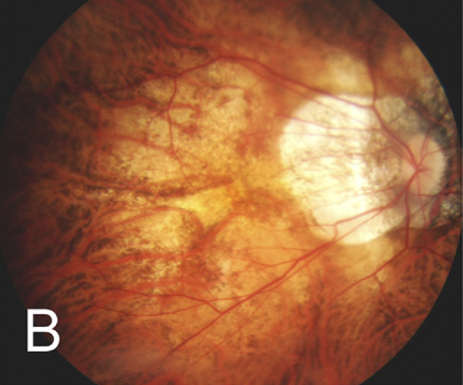 |
| The rapid progression trajectory group carried a higher risk of poorer visual prognosis, and thus, future studies are needed for early identification of rapid axial elongation and appropriate intervention. Photo: Julie Poteet, OD. Click image to enlarge. |
The ability to discern whether high myopia will remain stable or undergo rapid progression has implications for clinical management, including determining follow-up frequency, deciding on aggressive clinical interventions and optimizing visual outcomes. Researchers in China sought to determine distinct axial length (AL) elongation profiles (called trajectories by the team) and related visual outcomes in patients with high myopia across different age groups. They identified three distinct patterns of progression after eight years of follow-up: stable (0.02mm/year), moderate (0.12mm/year) and rapid (0.38mm/year). After these eight years, the rapid progression trajectory was associated with a higher risk of developing pathological myopic macular degeneration and poorer best-corrected visual acuity compared with the stable progression trajectory. The researchers presented this finding in a recent study published in JAMA Ophthalmology.1
A total of 793 participants (median age 17.8; range 6.8 to 69.7; 52.7% female) and 1,586 eyes were included in the analyses. Participants were grouped according to baseline age as children and adolescents (7 to <18 years), young adults (18 to <40 years) and older adults (≥40 to 70 years). Mean axial elongation rates were 0.46mm/year for children and adolescents, 0.07mm/year for young adults, and 0.13mm/year for older adults.
At eight years of follow-up, compared with the stable progression trajectory, the rapid progression trajectory was associated with a 6.92x higher risk of developing pathological myopic macular degeneration, defined as diffuse or patchy chorioretinal atrophy or macular atrophy; odds ratio: 6.92. The rapid progression trajectory was also associated with a 0.032 logMAR decrease in best-corrected visual acuity. Younger age and longer AL at baseline were risk factors for faster axial growth and for being in a faster progression trajectory.
“These distinct axial elongation trajectories could prove valuable for early identification and intervention for high-risk individuals,” the researchers wrote in their paper. “These findings support the possibility that lifetime management could be considered in individuals with high myopia and warrant continued research on AL growth patterns and associated factors.”1
A commentary, also published in JAMA Ophthalmology, discussed how the exploration of axial length trajectories may predict onset and severity of myopia.2 “Normative values can guide diagnosis and allow for timely interventions,” the author of the commentary wrote. “Given the association of increased axial length with myopia, is it feasible and worthwhile to add axial length trajectory to standard childhood reference data?” To some degree, it seems.
“Having a longer axial length does not mean a child has myopia, as it may be due to the child being larger, older, taller or male,” the author added. “However, an axial length trajectory increasing faster than the normal age-related increase is likely to predict earlier myopia onset and greater severity of myopia.”
Monitoring trajectories of axial elongation could help identify those at high risk of pathological myopia. “Given the increasing availability of ocular biometry instruments, a normative reference of axial length and axial length trajectories in children could be accomplished in many areas in the world,” the commentary suggested. “Such national and international references will help to identify not only premyopia in children but also those at increased risk of myopia-related complications.”2
1. Zhang S, Chen Y, Li Z, et al. Axial elongation trajectories in Chinese children and adults with high myopia. JAMA Ophthalmol. December 28, 2023. [Epub ahead of print]. 2. Mackey DA, Lee SS. Emerging role of axial length trajectories in the management of myopia. JAMA Ophthalmol. December 28, 2023. [Epub ahead of print]. |

